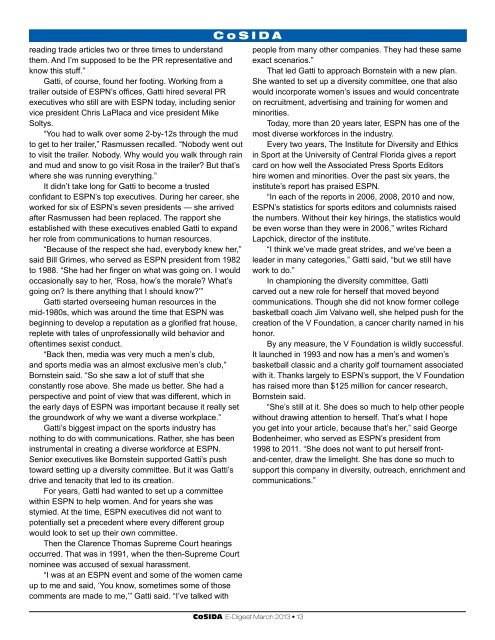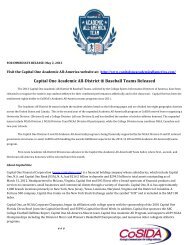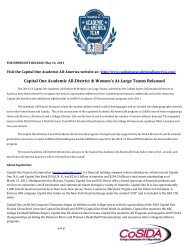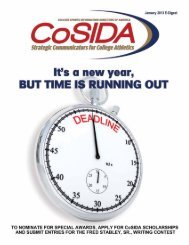CoSIDA E-Digest March 2013 • 1
CoSIDA E-Digest March 2013 • 1
CoSIDA E-Digest March 2013 • 1
You also want an ePaper? Increase the reach of your titles
YUMPU automatically turns print PDFs into web optimized ePapers that Google loves.
eading trade articles two or three times to understand<br />
them. And I’m supposed to be the PR representative and<br />
know this stuff.”<br />
Gatti, of course, found her footing. Working from a<br />
trailer outside of ESPN’s offices, Gatti hired several PR<br />
executives who still are with ESPN today, including senior<br />
vice president Chris LaPlaca and vice president Mike<br />
Soltys.<br />
“You had to walk over some 2-by-12s through the mud<br />
to get to her trailer,” Rasmussen recalled. “Nobody went out<br />
to visit the trailer. Nobody. Why would you walk through rain<br />
and mud and snow to go visit Rosa in the trailer? But that’s<br />
where she was running everything.”<br />
It didn’t take long for Gatti to become a trusted<br />
confidant to ESPN’s top executives. During her career, she<br />
worked for six of ESPN’s seven presidents — she arrived<br />
after Rasmussen had been replaced. The rapport she<br />
established with these executives enabled Gatti to expand<br />
her role from communications to human resources.<br />
“Because of the respect she had, everybody knew her,”<br />
said Bill Grimes, who served as ESPN president from 1982<br />
to 1988. “She had her finger on what was going on. I would<br />
occasionally say to her, ‘Rosa, how’s the morale? What’s<br />
going on? Is there anything that I should know?’”<br />
Gatti started overseeing human resources in the<br />
mid-1980s, which was around the time that ESPN was<br />
beginning to develop a reputation as a glorified frat house,<br />
replete with tales of unprofessionally wild behavior and<br />
oftentimes sexist conduct.<br />
“Back then, media was very much a men’s club,<br />
and sports media was an almost exclusive men’s club,”<br />
Bornstein said. “So she saw a lot of stuff that she<br />
constantly rose above. She made us better. She had a<br />
perspective and point of view that was different, which in<br />
the early days of ESPN was important because it really set<br />
the groundwork of why we want a diverse workplace.”<br />
Gatti’s biggest impact on the sports industry has<br />
nothing to do with communications. Rather, she has been<br />
instrumental in creating a diverse workforce at ESPN.<br />
Senior executives like Bornstein supported Gatti’s push<br />
toward setting up a diversity committee. But it was Gatti’s<br />
drive and tenacity that led to its creation.<br />
For years, Gatti had wanted to set up a committee<br />
within ESPN to help women. And for years she was<br />
stymied. At the time, ESPN executives did not want to<br />
potentially set a precedent where every different group<br />
would look to set up their own committee.<br />
Then the Clarence Thomas Supreme Court hearings<br />
occurred. That was in 1991, when the then-Supreme Court<br />
nominee was accused of sexual harassment.<br />
“I was at an ESPN event and some of the women came<br />
up to me and said, ‘You know, sometimes some of those<br />
comments are made to me,’” Gatti said. “I’ve talked with<br />
<strong>CoSIDA</strong><br />
<strong>CoSIDA</strong> E-<strong>Digest</strong> <strong>March</strong> <strong>2013</strong> <strong>•</strong> 13<br />
people from many other companies. They had these same<br />
exact scenarios.”<br />
That led Gatti to approach Bornstein with a new plan.<br />
She wanted to set up a diversity committee, one that also<br />
would incorporate women’s issues and would concentrate<br />
on recruitment, advertising and training for women and<br />
minorities.<br />
Today, more than 20 years later, ESPN has one of the<br />
most diverse workforces in the industry.<br />
Every two years, The Institute for Diversity and Ethics<br />
in Sport at the University of Central Florida gives a report<br />
card on how well the Associated Press Sports Editors<br />
hire women and minorities. Over the past six years, the<br />
institute’s report has praised ESPN.<br />
“In each of the reports in 2006, 2008, 2010 and now,<br />
ESPN’s statistics for sports editors and columnists raised<br />
the numbers. Without their key hirings, the statistics would<br />
be even worse than they were in 2006,” writes Richard<br />
Lapchick, director of the institute.<br />
“I think we’ve made great strides, and we’ve been a<br />
leader in many categories,” Gatti said, “but we still have<br />
work to do.”<br />
In championing the diversity committee, Gatti<br />
carved out a new role for herself that moved beyond<br />
communications. Though she did not know former college<br />
basketball coach Jim Valvano well, she helped push for the<br />
creation of the V Foundation, a cancer charity named in his<br />
honor.<br />
By any measure, the V Foundation is wildly successful.<br />
It launched in 1993 and now has a men’s and women’s<br />
basketball classic and a charity golf tournament associated<br />
with it. Thanks largely to ESPN’s support, the V Foundation<br />
has raised more than $125 million for cancer research,<br />
Bornstein said.<br />
“She’s still at it. She does so much to help other people<br />
without drawing attention to herself. That’s what I hope<br />
you get into your article, because that’s her,” said George<br />
Bodenheimer, who served as ESPN’s president from<br />
1998 to 2011. “She does not want to put herself frontand-center,<br />
draw the limelight. She has done so much to<br />
support this company in diversity, outreach, enrichment and<br />
communications.”
















